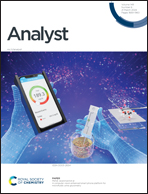Polymeric membrane potentiometric antibiotic sensors using computer-aided screening of supramolecular macrocyclic carriers†
Abstract
Carrier-based polymeric membrane potentiometric sensors are an ideal tool for detecting ionic species. However, in the fabrication of these sensors, the screening of carriers still relies on empirical trial- and error-based optimization, which requires tedious and time-consuming experimental verification. In this work, computer-aided screening of carriers is applied in the preparation of polymeric membrane potentiometric sensors. Molecular docking is used to study the host–guest interactions between receptors and targets. Binding energies are employed as the standard to screen the appropriate carrier. As a proof-of-concept experiment, the antibiotic ciprofloxacin is selected as the target model. A series of supramolecular macrocyclic receptors including cyclodextrins, cucurbiturils and calixarenes are chosen as potential receptors. The proposed sensor based on the receptor calix[4]arene screened by molecular docking shows a lower detection limit of 0.5 μmol L−1 for ciprofloxacin. It can be expected that the proposed computer-aided screening technique of carriers can provide a simple but highly efficient method for the fabrication of carrier-based electrochemical and optical sensors.

- This article is part of the themed collection: Analyst HOT Articles 2024


 Please wait while we load your content...
Please wait while we load your content...